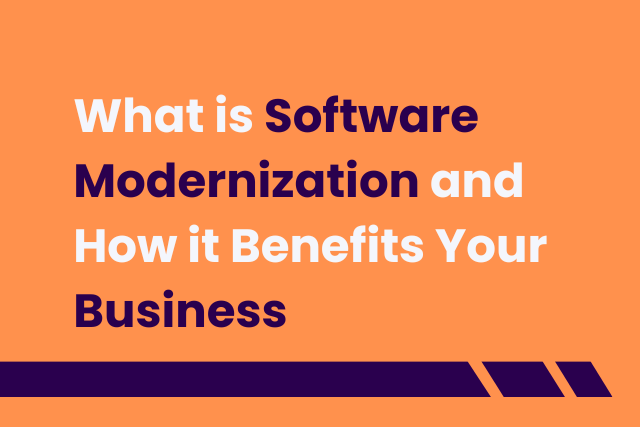In our current times, software modernization is important for any business, be it a large enterprise or startups and small businesses because technology is evolving at an unprecedented pace. If we compare the level of technological advancements from the past 10 years to today, we seldom find similar technologies which were used then.
In order for businesses to stay relevant and competitive they need to modernize their legacy systems which helps them align with current trends. However, many of them may hesitate to completely replace their existing systems with modern ones, or they may have concerns about how to migrate legacy systems into modern infrastructure.
Let’s see what software modernization is first, then we will discuss about its benefits and how efficiently businesses can modernize their digital infrastructure.
What is Software Modernization
Software modernization involves modernizing legacy systems. It is done by either equipping them with new technology or completely transforming legacy systems into modern systems, which could be physical systems, software, applications, or any other technology.
But it is valuable for businesses to modernize legacy systems and not replace entire legacy systems with modern technology, mainly because older technology, systems, or applications may contain invaluable information which may be key for some businesses.
So, ultimately software modernization combines the practice of transforming legacy systems and keeping them by integrating into modern technologies. At this stage, you should have a clear idea of what constitutes a legacy system.
What is a Legacy System
A legacy system can be an older computer hardware or software systems, coding languages, architectures, or any other technology that may have been relevant in the past but not in current times. They may have served their purpose in the older times but have become obsolete now, which prompts organizations to equip themselves with relevant technologies.
Yet, many businesses still use legacy systems. The reason could be that some businesses may be obliged to use the legacy systems due to contractual obligations, some believe that the cost of modernizations can be hefty, and some just don’t want the change.
Despite all these, businesses need to modernize their legacy systems which helps them not to miss out on adopting the latest technology. It helps them to be compliant with the current developments and stay in the game in this dynamic business environment. In fact, current businesses are adopting an increased proportion of SaaS solutions which come highly scalable and cost-effective.
Modernize Your Legacy Systems in Five Simple Steps
To modernize your IT infrastructure, you do not have to lose all the benefits you reaped so far using legacy systems. Instead, find the right strategy which helps you migrate your old systems into modern platforms and also keep legacy systems by integrating them into modern technology.
Understand Your Current Infrastructure
Before starting out, thoroughly assess your current systems and identify critical functionalities and components of your entire IT infrastructure. Once you do that, you will have a clear view of each system, its capabilities, and issues associated with them, which helps you pinpoint critical issues that might hinder user experience and other processes, including performance and growth.
In this process, do not neglect the cost associated with each system which mostly includes maintenance costs. Then create a list of systems which need to be modernized because this saves the cost of modernization which would otherwise be expensive to modernize your entire systems at once.
Conduct Competitor Analysis
Carefully analyzing your competitors helps you learn the best strategies they follow and you can analyze the results they bring to their businesses. This lets you keep up with your competitors as you can understand which architecture works best and which systems you should prioritize for modernizing.
Moreover, consider how software modernization techniques can enhance your business outcomes which, in turn, helps you effectively plan your software modernization strategy. To stand out from your competitors, you can consider investing in custom software development with which you can replace legacy systems with modern custom software.
Choose Modernization Strategy
Now, the important step is to find the right modernization strategy that works for you. You have three widely used approaches to choose from, which are reuse, replace, and rewrite.
Rewrite
In this approach, the migration team rewrites the code in the relevant and modern development language, which helps you modernize your applications seamlessly. This modernization approach reduces the inherent complexity as well as cost associated with it, which also consumes a lesser time frame.
Reuse
This approach lets your legacy systems be fine-tuned to support modern operations as you will be able to integrate relevant technology into these systems for enhanced performance. Here, you can modify the system step by step and then test along the way which ensures optimal performance.
Replace
This is rather a costly approach in which the modernization team replaces all the legacy systems with modern ones, which often involves building an entire system from scratch. The newly developed systems may include semi off-the-shelf components which mirror some of the functionalities of your legacy systems.
Carefully consider the time frame and costs associated with each strategy then choose the one that best suits your organizational needs.
Create a Strategy Roadmap
It is imperative that you have a clear and concise technology roadmap for effective software modernization specific to your business. It helps you define your overall business objectives, goals to reach, and challenges to address along the way. Further, the strategy helps you break complex goals into smaller milestones which you can assign to specific teams.
Set Your Documentation Right
We cannot emphasize enough the importance of documenting each and every step involved in software modernization as it ensures that all stakeholders are on the same page. It is important for you to have a unified documentation which details all the steps and processes undertaken, no matter how big or small they are. It’s because proper documentation ensures high visibility, transparency, and makes it easy to address any challenges, then and there.
Start Modernizing
The final step and the most important step is to know when and how to initiate the process of modernizing your legacy systems. You have flexibility in choosing how you want to conduct this process, either to modernize in one go or do step-by-step modernization.
You also need to consider which part of your organizational system you should take first, which is based on the complexity and interdependency of systems.
It is ideal to carry out the process one step at a time which helps you seamless and smooth modernization without hindering your regular operations. It also gives time for testing and the teams to get used to the modernized infrastructure.
How Software Modernization Benefits You
Software modernization brings many benefits to your organization, which range from cost optimization to boosting performance. We have compiled some key benefits below:
Better Performance
Since legacy systems have comparatively old technology and low compatibility, their performance will not be matched given the current technology developments. It results in decreased operational efficiency which will often be coupled with downtime and crashes. But modernizing legacy systems clears all these issues as modern IT infrastructure will be highly compatible which boosts business efficiency and ensures your systems perform at optimal levels.
Highly Scalable
Legacy systems were built more or less in robust ways which are not so flexible. You may find it difficult to tune legacy systems in your way as your business grows. But with modern infrastructure, you have the freedom to modify the system in tune with your business requirements. You can opt for cloud modernization services which gives you flexibility to easily scale up or down the resources as per your business demands.
Less Cost
Cost efficiency is one of the biggest factors why many businesses prefer modernizing their IT infrastructure because maintaining legacy systems incurs high costs year on year. However, if you totally replace your existing legacy systems with modern ones, the costs may go incredibly high, mainly because of the expenses related to building new systems and training your teams. However, with structured approach, you can maintain cost efficiency and modernize your systems at the same time.
High Security
As cyber threats are looming, legacy systems may be at higher risks as they may not have been equipped with proper security measures. But, modern systems allow you to incorporate best security practices like data encryption, multi-factor authentication, providing secure access controls, and many more.
Moreover, with modern systems, you can stay compliant with current security frameworks, which saves you from unwanted penalties and fines. Modern systems allow you to implement robust cybersecurity solutions, as you can keep your organization secure and safe.
To Wrap Up
Evolving market and technology trends demand modern IT infrastructure as your legacy systems may not be suitable to carry out your operations efficiently. With software modernization, you will be able to access the benefits of new and relevant technology and future-proof your business.




